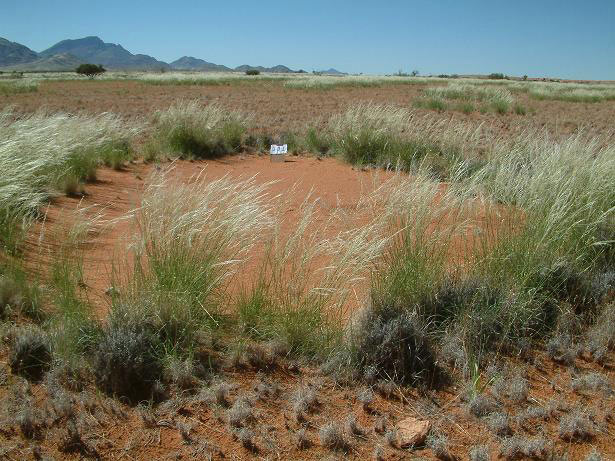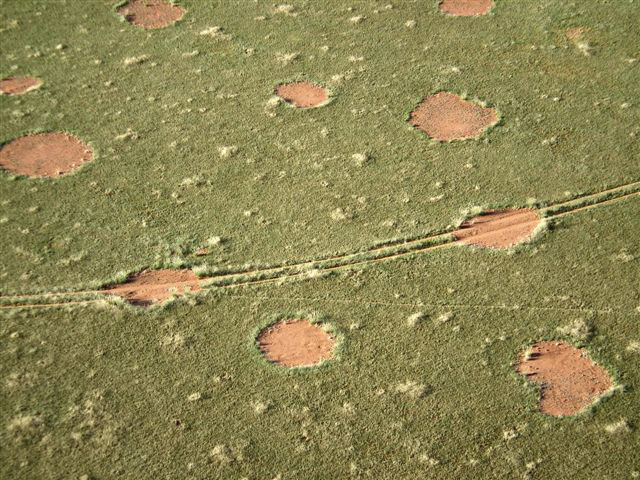
Mysterious African 'Fairy Circles' Stump Scientists

In the sandy desert grasslands of Namibia in southern Africa, mysterious bare spots known as "fairy circles" will form and then disappear years later for no reason anyone can determine. A new look at these strange patterns doesn't solve the wistful mystery but at least reveals that the largest of the circles can linger for a lifetime.
Small fairy circles stick around an average of 24 years, while larger ones can exist as long as 75 years, according to research detailed today (June 27) in the journal PLoS ONE. Still, the study sheds little light on why the circles form, persist and then vanish into the landscape after decades.
"The why question is very difficult," said study researcher Walter Tschinkel, a biologist at Florida State University. "There are a number of hypotheses on the table, and the evidence for none of them is convincing." [See Photos of Fairy Circles]
Circles of life (and death)
Tschinkel grew interested in fairy circles during a 2005 safari to NamibRand Nature Reserve in southwest Namibia, in the Namib Desert. It was his first experience with the round clearings, tens of thousands of which expose the red sandy soil in the area. A short time after the circles form, a tall ring of grass grows around the border, highlighting the bare area.

Few researchers have studied fairy circles, in part because of their remoteness, 111 miles (180 km) from the nearest village. It's an arid landscape where springbok, ostriches, leopards and other large animals roam, Tschinkel told LIveScience.
"It's like dying and going to heaven if you like remote, beautiful desert places," he said.
Sign up for the Live Science daily newsletter now
Get the world’s most fascinating discoveries delivered straight to your inbox.
At first glance, Tschinkel assumed the circles marked underground nests of harvester termites. But digs have shown no evidence of termite nests under fairy circles. Other explanations, such as differences in soil nutrients or the death of seedlings by toxic vapors from the ground, have likewise failed to hold up to study.
In fact, little was known even about the life cycle of the circles, Tschinkel said. With the help of the nature reserve's staff, satellite images and aerial photos, he set out to change that. By comparing satellite images from 2004 and 2008, he found that circles are quite stable, popping up at nearly their full size, or growing quickly to full size once they get started. The smallest are about 6.5 feet (2 meters) in diameter, while the largest can be almost 40 feet (12 m) across. Winds scour the bare areas of soil, turning them into slight depressions. Eventually plants move back in, recolonizing the circles and leaving only slightly indented "ghost circles" behind. [Gallery: Aerial Photos Reveal Mysterious Stone Structures]
Assuming that the overall number of fairy circles on the landscape is fairly steady, Tschinkel used the satellite photos to look at how quickly the circles go from birth to maturity to revegetation. That yielded rough estimates of the circles' life spans. Most probably exist for 30 to 60 years, Tschinkel said.
Persisting mystery
Tschinkel was able to bolster these estimates thanks to a fundraising effort by the Namib Rand Nature Reserve, which sells sponsorships to fairy circles. The sponsored circles are marked with a ceramic plate, and their GPS coordinates are recorded. Over the 10 years of the sponsorship program, staff members have checked on the status of the sold circles. Their data yielded similar age ranges for fairy circles as the satellite images did, Tschinkel found.
He also determined that the circles form only on sandy soil with minimal stoniness, and that they don't form on shifting dunes or alluvial fans, where sands are deposited by water.
Some of Tschinkel's experiments are still ongoing, but so far, they've generated no leads on the circles' origins. Tschinkel suspects the circles are the product of some form of natural self-organization by plants.
"There are some mathematical models that are based on the idea that plants can withdraw resources toward themselves, which has a positive feedback on plant growth where they're located, but it has a negative effect on plants at a greater distance," he said.
Computer models based on this math can generate landscapes that look a bit like the fairy circle fields of Namibia, he said. But even if that hypothesis is on the right track, it doesn't explain how the plants are creating this pattern, not when hoarding soil nutrients and some other possible factors have already been ruled out.
With few people studying the circles — and no funding for chasing down the mysteries of the landscape of southern Africa — Tschinkel said the fairy circles will likely remain an enigma.
"I'm not too worried that this mystery is going to be solved anytime soon," he said. And the persistence of the mystery makes it ever more intriguing.
"That's science, isn't it?" Tschinkel said. "If you knew the answer ahead of time, it wouldn't be much fun."
Follow Stephanie Pappas on Twitter @sipappas or LiveScience @livescience. We're also on Facebook & Google+.

Stephanie Pappas is a contributing writer for Live Science, covering topics ranging from geoscience to archaeology to the human brain and behavior. She was previously a senior writer for Live Science but is now a freelancer based in Denver, Colorado, and regularly contributes to Scientific American and The Monitor, the monthly magazine of the American Psychological Association. Stephanie received a bachelor's degree in psychology from the University of South Carolina and a graduate certificate in science communication from the University of California, Santa Cruz.









